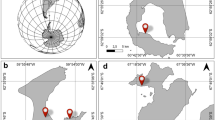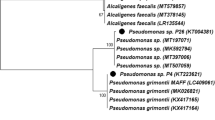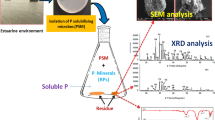Abstract
Possibility of perchlorate reduction by microbes raises hope for an eco-friendly mode of degradation of this toxic rocket fuel. This study reports 3 isolates (A1, A2 and A3) capable of molybdenum-independent degradation of perchlorate under aerobic conditions. The rate of degradation was the highest when perchlorate concentration was 17 mM, and then 3.2 mM, 4.7 mM and 4.1 mM of perchlorate was reduced by isolates A1, A2 and A3 (respectively) after 72 h at 28°C under aerobic conditions. Presence of perchlorate at a concentration higher than 17 mM resulted in some inhibition of perchlorate reduction. 16S ribosomal RNA gene analysis revealed isolate A1 to bePseudomonas stutzeri (Proteobacteria) while isolates A2 ad A3 where found to belong to the genusArthrobacter (Actinobacteria). The study, apart from demonstrating ribotyping as a rapid method of identification of economically important soil microbes, also raised prospects for using artificial consortia for environmental degradation of perchlorate, without apparent domination ofDechloromonas spp. (a group of microbes known for perchlorate remediation in the environment).
Similar content being viewed by others
References
Altschul SF, Madden TL, Schäffer AA, Zhang J, Zhang Z, Miller W, Lipman DJ, 1997. Gapped BLAST and PSI-BLAST: a new generation of protein database search programs. Nucleic Acids Res 25: 3389–3402.
Altschul SF, Boguski MS, Gish W, Wootton JC, 1994. Issues in searching molecular sequence databases. Nature Genetics 6: 119–129.
Aslander A, 1928. Experiments on the eradication of Canada Thistle, Cirsium arvense, with chlorates and other herbicides. J Agric Res 36: 915–928.
Bruce RA, Achenbach LA, Coates JD, 1999. Reduction of perchlorate by a novel organism isolated from paper mill waste. Environ Microbiol 1: 319–329.
Chaudhuri SK, O’Connor SM, Gustavson RL, Achenbach LA, Coates JD, 2002. Environmental factors that control microbial perchlorate reduction. Appl Environ Microbiol 68: 4425–4430.
Clark JJJ, 2000. Perchlorate in the environment. In: Urbansky ET, ed. Toxicology of perchlorate, New York: Kluwer Academic/Plenum: 15–30.
Coates JD, Michaelidou U, Bruce RA, O’Connor SM, Crespi JN, Achenbach LA, 1999. The ubiquity and diversity of dissimilatory (per)chlorate reducing bacteria. Appl Environ Microbiol 65: 5234–5241.
Coates JD, Achenbach LA, 2004. Microbial perchlorate reduction: rocket-fuelled metabolism. Nature reviews Microbiology 2: 569–579.
Coates JD, 1999. The ubiquity and diversity of perchlorate reducing bacteria. Appl Environ Microbiol 65: 5234–5241.
Coventry DR, Hirth JR, Fung KKH, 1987. Nutritional restraints on subterranean clover grown on acid soils used for crop-pasture rotation. Aust J Agric Res 38: 163–176.
Doerge TA, Bottomley PJ, Gardner EH, 1985. Molybdenum limitations to alfalfa growth and nitrogen content on a moderately acid, high-phosphorous soil. Agron J 77: 895–901.
Erickson GE, 1961. The Chile nitrate deposits. Am Sci: 366–374.
Garrity GM, Bell JA, Lilburn TG, 2004. Taxonomic Outline of the Prokaryotes. In: Bergey’s Manual of Systematic Bacteriology, 2nd edn. Release 5.0.
Graham PH, 1998. Biological dinitrogen fixation: symbiotic. In: Sylvia DM, Fuhrmann JJ, Hartel PG, Zuberer DA, eds. Principles and applications of soil microbiology. Prentice-Hall, Inc., Englewood Cliffs, N. J.: 322–345.
Howdeshell KL, 2002. A model of the development of the brain as a construct of the thyroid system. Environ Health Perspect 110: 337–348.
Konnert JA, 1994. Minerological studies of nitrate deposits of Chile: two new saline minerals with the composition K6(Na,K)a Na 6 Mg10(XO4)12(H2): fuenzalidaite (x=s) and carlosruizite (X=Se). Am Mineral 79: 1003–1008.
Logan BE, Zhang H, Mulvaney P, Milner MG, Head IM, Unz RF, 2001. Kinetics of perchlorate and chlorate-respiring bacteria. Appl Environ Microbiol 67: 2499–2506.
Malmqvist A, Welander T, Moore E, Ternstrom A, Molin G, Stenstrom IN, 1994.Ideonella dechloratans gen. nov. sp. nov, anew bacterium capable of growing anaerobically with chlorate as an electron acceptor. Sys Appl Microbiol 17: 58–64.
O’Connor SM, Coates JD, 2002. A universal immuno-probe for (per)chlorate-reducing bacteria. Appl Environ Microbiol 68: 3108–3113.
Okeke BC, Giblin T, Frankenberger WT, 2002. Reduction of perchlorate and nitrate by salt tolerant bacteria. Environ Pollut 118: 357–363.
Porterfield SP, 1994. Vulnerabilities of the developing brain to thyroid abnormalities: environmental insults to the thyroid system. Environ Health Perspect 102: 125–130.
Renner R, 2003. Perchlorate regulation faces further delay. Environ Sci Technol 37: 166A-167A.
Renner R, 1998. Perchlorate tainted wells spur government. Environ Sci Technol 33: 210A-214A.
Urbansky ET, 1998. Perchlorate chemistry: implications for analysis and remediation. Bioremed J 2: 81–95.
Urbansky ET, Schock MR, 1999. Issues in managing the risk associated with perchlorate in drinking water J Environ Manage 56: 79–95.
van Ginkel CG, Plugge CM, Stroo CA, 1995. Reduction of chlorate with various energy substrates and inocula under anaerobic conditions. Chemosphere 31: 4057–4066.
Wallace W, Ward T, Breen A, Attaway H, 1996. Identification of an anaerobic bacterium, which reduces perchlorate and chlorate asWolinella succinogenes. J Indust Microbiol 16: 68–72.
Waller AS, 2004. Perchlorate reducing microorganisms isolated from contaminated sites Environ Microbiol 6: 517–527.
Weisburg WG, Barns SM, Pelletier DA, Lane DJ, 1991. 16S ribosomal DNA amplification for phylogenetic study. J Bacteriol 173: 697–703.
Woese CR, 1987. Bacterial evolution. Microbial Rev 51: 221–271.
Wolff J, 1998. Perchlorate and the thyroid gland. Pharmacol Rev 50: 89–105.
Zhang H, Bruns MA, Logan BE, 2002. Perchlorate reduction by a novel chemolithotrophic hydrogen-oxidizing bacterium. Environ Microbiol 4: 570–576.
Author information
Authors and Affiliations
Corresponding author
Rights and permissions
About this article
Cite this article
Shete, A., Mukhopadhyaya, P.N., Acharya, A. et al. Aerobic reduction of perchlorate by bacteria isolated in Kerala, South India. J Appl Genet 49, 425–431 (2008). https://doi.org/10.1007/BF03195643
Received:
Accepted:
Issue Date:
DOI: https://doi.org/10.1007/BF03195643




